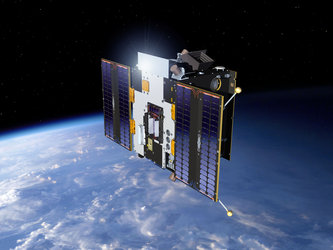Accept all cookies Accept only essential cookies See our Cookie Notice

About ESA
The European Space Agency (ESA) is Europe’s gateway to space. Its mission is to shape the development of Europe’s space capability and ensure that investment in space continues to deliver benefits to the citizens of Europe and the world.
Highlights
ESA - United space in Europe
This is ESA ESA facts Member States & Cooperating States Funding Director General Top management For Member State Delegations European vision European Space Policy ESA & EU Space Councils Responsibility & Sustainability Annual Report Calendar of meetings Corporate newsEstablishments & sites
ESA Headquarters ESA ESTEC ESA ESOC ESA ESRIN ESA EAC ESA ESAC Europe's Spaceport ESA ESEC ESA ECSAT Brussels Office Washington OfficeWorking with ESA
Business with ESA ESA Commercialisation Gateway Law at ESA Careers Cyber resilience at ESA IT at ESA Newsroom Partnerships Merchandising Licence Education Open Space Innovation Platform Integrity and Reporting Administrative Tribunal Health and SafetyMore about ESA
History ESA Historical Archives Exhibitions Publications Art & Culture ESA Merchandise Kids Diversity ESA Brand CentreLatest
Space in Member States
Find out more about space activities in our 23 Member States, and understand how ESA works together with their national agencies, institutions and organisations.
Science & Exploration
Exploring our Solar System and unlocking the secrets of the Universe
Go to topicAstronauts
Missions
Juice Euclid Webb Solar Orbiter BepiColombo Gaia ExoMars Cheops Exoplanet missions More missionsActivities
International Space Station Orion service module Gateway Concordia Caves & Pangaea BenefitsLatest
Space Safety
Protecting life and infrastructure on Earth and in orbit
Go to topicAsteroids
Asteroids and Planetary Defence Asteroid danger explained Flyeye telescope: asteroid detection Hera mission: asteroid deflection Near-Earth Object Coordination CentreSpace junk
About space debris Space debris by the numbers Space Environment Report In space refuelling, refurbishing and removingSafety from space
Clean Space ecodesign Zero Debris Technologies Space for Earth Supporting Sustainable DevelopmentLatest
Applications
Using space to benefit citizens and meet future challenges on Earth
Go to topicObserving the Earth
Observing the Earth Future EO Copernicus Meteorology Space for our climate Satellite missionsCommercialisation
ESA Commercialisation Gateway Open Space Innovation Platform Business Incubation ESA Space SolutionsLatest
Enabling & Support
Making space accessible and developing the technologies for the future
Go to topicBuilding missions
Space Engineering and Technology Test centre Laboratories Concurrent Design Facility Preparing for the future Shaping the Future Discovery and Preparation Advanced Concepts TeamSpace transportation
Space Transportation Ariane Vega Space Rider Future space transportation Boost! Europe's Spaceport Launches from Europe's Spaceport from 2012Latest

DSLP in-flight test results
Thank you for liking
You have already liked this page, you can only like it once!
Preliminary scientific analysis of uncalibrated DSLP (Dual Segmented Langmuir Probe) data set acquired from one full Proba 2 orbit during the commissioning phase. Main scientific products from measured current-voltage characteristics (upper panel) represent electron and ion densities and electron temperature (two middle panels). Bottom panel displays S/C latitude and longitude. Several typical large scale features are already clearly visible in the first data sets. A substantial decrease of measured current is observed roughly between 15:28 and 15:43 UTC and disturbances in observed densities and electron temperature are related to crossing of the CUSP region at the north pole where Proba 2 S/C also entered into the eclipse. On the other hand, increased measured current, and thus plasma density, is observed in the equatorial region on the dusk side of the orbit (around 14:25 and 16:02 UTC) - a typical ionospheric phenomenon known as the equatorial anomaly.
Initial in-flight tests of the DSLP instrument were performed during the Proba-2 commissioning phase within the third and forth week after the launch of the satellite. First connection with the DSLP processing unit was successfully established on November 18, 2009, and data acquired in the mission operations centre (Redu, Belgium) confirmed a good health status of the whole experiment. In the following days, the DSLP team verified
the functionality and data acquisition in all DSLP scientific modes. Till now, already more than 15 000 scientific data samples were acquired including current-voltage characteristics from all DSLP segments and also electric filed measurements between the two DSLP sensors. Preliminary scientific analysis of DSLP measurements shows good qualitative agreement with theoretical models and observed plasma characteristics are corresponding to predicted properties of ionospheric plasmas.
-
CREDIT
ESA/Academy of Sciences of the Czech Republic -
LICENCE
ESA Standard Licence

Proba-2 fully operational in its final orbit

Proba-2

Proba-V Flight Model undergoing mass measurement testing

Proba-2















 Germany
Germany
 Austria
Austria
 Belgium
Belgium
 Denmark
Denmark
 Spain
Spain
 Estonia
Estonia
 Finland
Finland
 France
France
 Greece
Greece
 Hungary
Hungary
 Ireland
Ireland
 Italy
Italy
 Luxembourg
Luxembourg
 Norway
Norway
 The Netherlands
The Netherlands
 Poland
Poland
 Portugal
Portugal
 Czechia
Czechia
 Romania
Romania
 United Kingdom
United Kingdom
 Slovenia
Slovenia
 Sweden
Sweden
 Switzerland
Switzerland
























